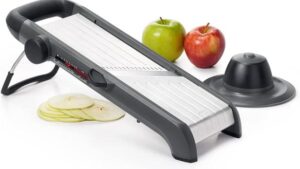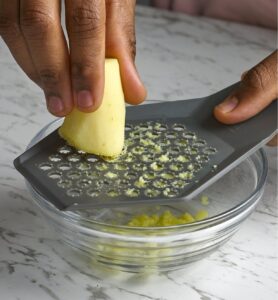The Grater’s Shape: A Key Factor for Efficiency and Safety
When it comes to kitchen tools, the grater is one of the most versatile and widely used gadgets. Its shape plays a crucial role in making it both efficient and safe to use. In this article, we’ll explore the different shapes of graters and how they contribute to the grater’s functionality and safety.
The most common shape of a grater is the rectangular box grater. This shape provides multiple sides with different-sized shredding and grating holes. The larger holes are perfect for shredding cheese, while the finer holes are ideal for grating vegetables or citrus zest. The box shape also allows for a comfortable grip and provides stability when placed on the counter. The flat base of the box grater prevents it from tipping over and reduces the risk of accidents.

Another popular shape of a grater is the rotary or drum grater. The cylindrical shape allows for a more efficient and effortless grating process. The user simply inserts the food into the drum, turns the handle, and the grated food comes out of the other side. This shape is especially useful when grating hard cheeses like Parmesan or chocolate.
A flat grater, as the name suggests, has a flat surface with small, sharp holes. This shape is perfect for fine grating and shredding of soft cheeses, chocolate, and nuts. It’s also ideal for zesting citrus fruits as the small surface area ensures that only the outermost layer of the fruit is grated, giving the zest a fine texture.

Safety is a crucial factor when it comes to using a grater. The sharp edges and blades can cause serious injuries if not handled carefully. The shape of the grater can contribute to its safety. For example, box graters have a flat base that provides stability and reduces the risk of slipping. This shape also provides a comfortable grip, making it easy to hold while grating. Additionally, graters with non-slip bases and handles are also available, further increasing grip and safety.
The shape of the grater can also influence its durability. Box graters made of stainless steel are durable and long-lasting due to their shape. The flat base of the grater makes it less prone to bending or breaking, ensuring that it can withstand repeated use over time. This is especially important for commercial kitchens or for those who frequently use the grater at home.
When selecting a grater, it’s essential to consider the shape and how it will impact your usage. For example, if you need a grater for everyday use, such as shredding cheese for sandwiches, a box grater with multiple sides may be the best option. However, if you only need a grater for occasional use, a smaller flat grater may be more practical.
Another consideration when selecting a grater is the size of the holes. Large holes are ideal for shredding cheese, while smaller holes are excellent for grating carrots, zucchini, or chocolate. The size of the holes also affects the texture of the grated food. Smaller holes typically produce a finer texture, while larger holes create a coarser texture.
In conclusion, the shape of the grater plays a crucial role in its functionality, safety, and durability. The rectangular box grater provides multiple sides for different-sized holes, a comfortable grip, and stability. The cylindrical shape of the rotary or drum grater is ideal for efficient and effortless grating. The flat grater’s shape is perfect for fine grating and zesting. Additionally, the shape of the grater can also contribute to its safety and durability. So, the next time you’re in the market for a grater, consider the shape and how it can make your time in the kitchen more efficient and safer.